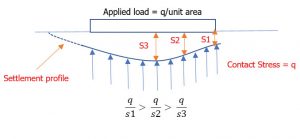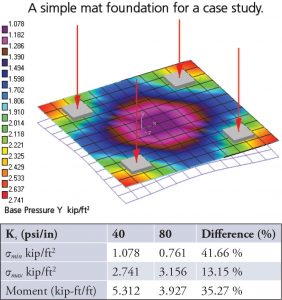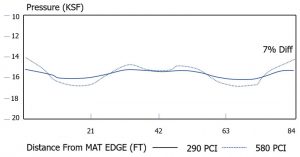Part 1: Fundamentals and Current Practices
Soil-Structure-Interaction (SSI) is a broad and interesting topic. Because of its complexity and unpredictability, engineers often require the use of sophisticated analysis techniques, including specialized software.
Modulus of subgrade reaction (Ks) is one of the key parameters used in mat (or raft) foundation design. It approximately represents soil response at any given point underneath a mat foundation. This key parameter is very useful for FEM-based mat foundation design. Spring constants can be calculated from Ks values, and corresponding spring supports can be applied underneath a foundation. A detailed discussion on this topic can be found on a related article titled, Correlation between Soil Bearing Capacity and Modulus of Subgrade Reaction (STRUCTURE, December 2013).
A mat foundation is often analyzed using a constant value of Ks. Many argue this approach is over-simplified and may yield erroneous output for the sake of convenience.
This article addresses this complex issue by first briefly discussing the theory and then providing a solution for FEM based mat foundation analysis. A new method (Settlement Profile Convergence Method) has been developed by the author to calculate and distribute Ks, and apply spring supports at all supporting points.
Subgrade Reaction
As the term suggests, contact pressure is the base pressure between the bottom of the foundation slab and the supporting subgrade medium. In other words, contact pressure is the subgrade reaction on the footing base due to the application of load on top of the foundation.
From observations, one can easily conclude that a loaded foundation will deflect and, as a result, the supporting subgrade medium will settle. The magnitude and the profile of the settlement will depend on soil characteristics, foundation properties, and loading. Determination of the contact pressure is crucial for foundation design, yet calculations can be very complicated. For larger foundations, like mats or rafts, determination of contact pressure can be even more complex. However, because of its importance, a simplified theory has been developed to estimate subgrade reaction; the theory is known as the theory of subgrade reaction.
The theory of subgrade reaction is primarily based on the following two assumptions:
- The soil medium is a perfectly elastic material. So, it obeys Hooke’s law and stress is linearly proportional to strain (or settlement).
- The ratio between base pressure, q, on the foundation and the corresponding soil settlement, s, will remain constant.

where, q = contact pressure or subgrade reaction
s = soil settlement
Ks is known as the coefficient of subgrade reaction or modulus of subgrade reaction.
It is important to note that the assumptions mentioned above are considered erroneous as the real contact pressure significantly differs from these simplified assumptions.
Contact Pressure and Settlement
A uniformly loaded flexible foundation on a perfectly elastic material of clay will have uniform base pressure and will take the shape of a bowl or trough. A foundation will suffer the maximum deflection at the center and will gradually reduce towards the edge (Figure 1).
As discussed above, modulus of subgrade reaction is the ratio between the contact pressure (q) and its corresponding settlement (s). For a uniformly loaded flexible foundation, contact pressure remains uniform throughout the foundation, but settlement decreases from the center towards the edge, so q/s or modulus of subgrade reaction increases from the center towards the edge (Figure 2).
It is reasonable to predict that the modulus of subgrade reaction will not be uniform, and it will increase from the foundation’s center towards the edge. It is known as variable modulus of subgrade reaction, which is part of the broader topic of Soil-Structure interaction (SSI).
The Winkler Spring
The current practice is to use a commercially available FEM program to analyze mat foundations. The foundation is typically modeled as bending plates, and the supporting soil is modeled as discrete compression-only springs connected to plate nodes. Those springs are known as Winkler springs. It is a popular modeling paradigm because of its simplicity.
Winkler idealized a soil model consisting of closely spaced identical but mutually independent linear springs. For such an idealized model, when the foundation is subjected to partial loading, foundation deformation is confined to the loaded region only. In other words, springs directly below the loaded area will be subjected to deflection, and any other springs beyond the loaded area will remain unaffected. For an arbitrary loaded area, spring deformation is directly proportional to the load applied on the top of the spring.
Terzaghi introduced modulus of subgrade reaction using the following mathematical expression.
where, q = contact pressure intensity and s = soil settlement
The above equation can be rewritten as
where, P = force on foundation, A = contact area, and s = soil settlement
It is similar to force-per-unit-volume or force-per-unit-area for unit deflection, or pressure for unit deflection.
Soil Continuity
The behavior of an idealized model is far from reality. The Winkler model lacks continuity within the supporting soil medium. Soil beyond the loaded area must be affected to maintain continuity. A very stiff foundation with stamp loading will settle uniformly just beneath the footing, but the continuity must remain with the supporting soil medium. Similarly, a flexible foundation will not settle uniformly under a uniformly distributed load and will maintain continuity with the supporting soil medium.
Effect on Design
As we look at the theory of subgrade reaction, it is essential to study the effects of three parameters on mat foundation design. Those parameters are:
- Uniform Ks and the numerical value of Ks
- Distribution of Ks
- Structural rigidity
Uniform Ks
As discussed earlier, current practice is to use FEM-based software packages to do mat foundation analysis. Also, most software packages accept input of a uniform Ks and automatically generate compression-only Winkler springs to model the supporting soil medium underneath the mat slab.
Case Study
Take the example of an elementary, square mat foundation supporting four columns and analyze the foundation with two different values of Ks; first with Ks = 40 pounds/in²/in and then Ks = 80 pounds/in²/in.
Modeling
Mat geometry: Square Mat 12 x 12 x 0.5 feet
Soil Modulus of Subgrade Reaction: 40 pounds/in²/in, 80 pounds/in²/in
Column Loading: 40 kips each (compressive)
Solution
A commercially available software, STAAD Foundation, has been chosen for the analysis. It automatically generates compression-only springs to model the supporting soil medium.
Study two types of output as followings:
- Effect on base pressure distribution
- Effect on bending moment
A summary of results is tabulated in Table 1, which shows considerable differences in results for different uniform Ks values. It can be concluded that engineers should select the value of Ks very carefully and should always seek help from qualified geotechnical engineers to provide the best-estimated value.
It should be noted that the model mentioned above is a straightforward mat foundation scenario with arbitrarily assumed mat dimensions and loading. In the next section, we will look at more realistic examples by referring to two published case studies.
Parametric Study
Mr. Horvilleur and Mr. Patel (SP-152: Design and Performance of Mat Foundations) studied the effects of different soil and structural parameters on mat foundation design, including dishing effect. The study was accompanied by parametric studies on two actual mat foundations, one of which is described below. The most critical parameters studied were:
- Mat Flexural Properties EI
- Effect of Mat Shear Deformations
- Modulus of Subgrade Reaction, Ks
The discussion herein is limited to Ks.
NCNB Corporate Center
The NCNB Corporate Center is a 60-story concrete building in which two different foundation systems were used. The perimeter columns were supported by deep concrete caissons bearing on 150 ksf rock. The core columns were supported on a core mat having dimensions 84 x 93 x 8 feet. The mat was founded on partially weathered rock with an average modulus of subgrade reaction of 290 pci (290 psi/in).
Two analyses were conducted. First using Ks = 290 psi/in and then Ks = 580 psi/in. Figure 3 shows variations for pressures and moments for two K values. The maximum change in pressures was 7%. However, there was a 30% change in positive moment and a 43% change in negative moment. It is interesting to note that the variations of the results are in line with the earlier simple case study.■
References
Terzaghi, Peck, Mesri. (1996). Soil Mechanics in Engineering Practice (Third Edition). Brentwood, CA. John Wiley & Sons.
Braja M Das. (1983). Advanced Soil Mechanics (International Edition) Washington. Hemisphere Publishing Corporation.
Joseph E. Bowles. (1996). Foundation Analysis and Design (Fifth Edition) New York City. McGraw-Hill.
J.F. Horvilleur, V. B. Patel. Mat Foundation Design. (1995). A Soil-Structure Interaction Problem. ACI SP-152-3.
E.J. Ulrich, Jr. (1995). Subgrade reaction in mat foundation design. ACI SP-152-4.
Apurba Tribedi. (2013). Correlation between Soil Bearing Capacity and Modulus of Subgrade Reaction. STRUCTURE, December 2013.




